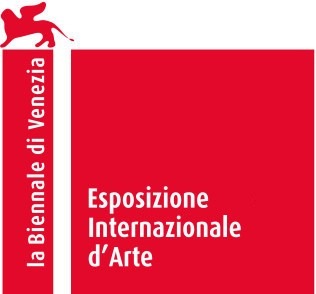58. Biennale di Venezia
The Milk of Dreams
23 Apr - 27 Nov 2022
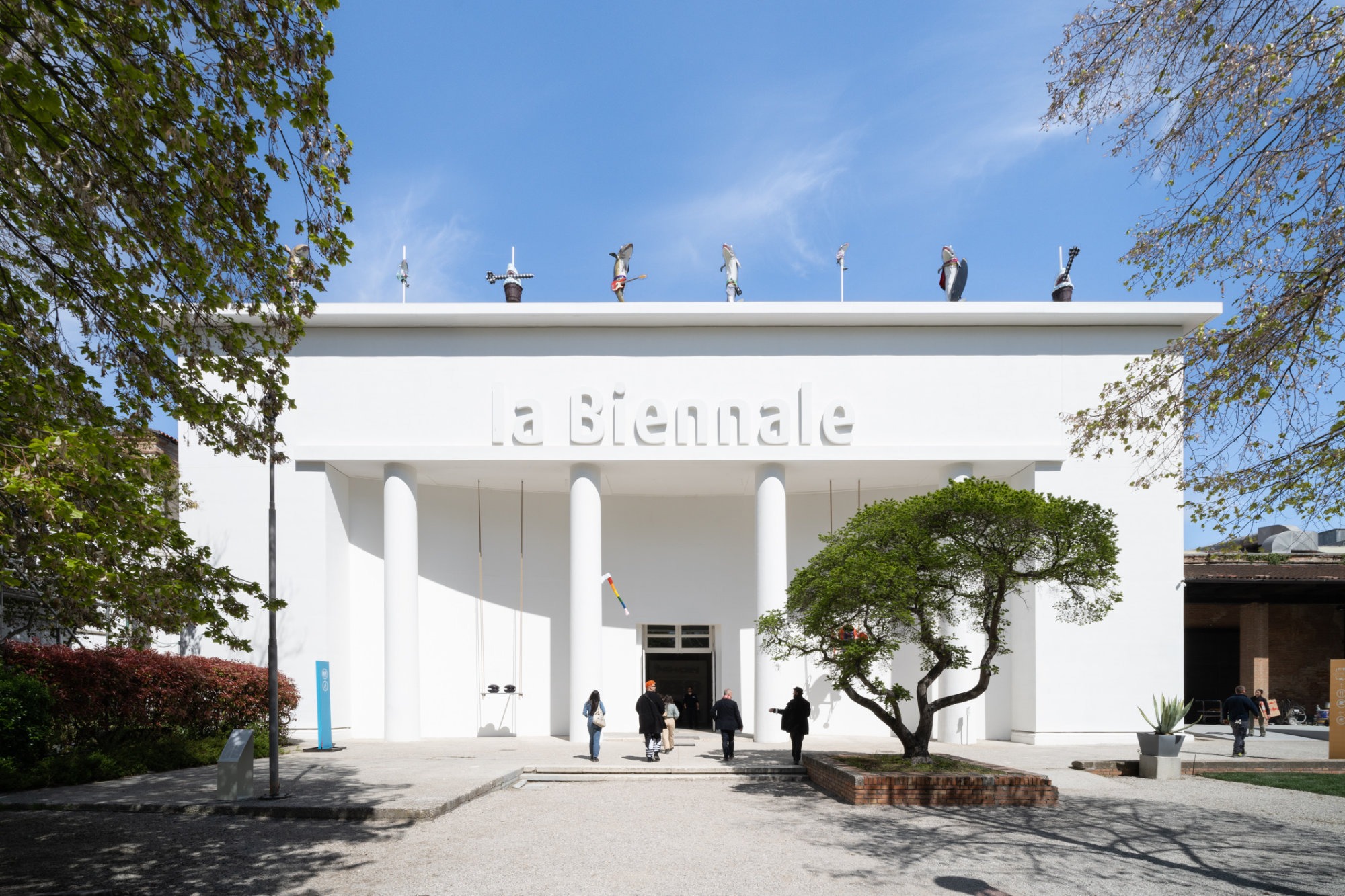
WHAT IF THEY BARK 01-07, 2022
Glass reinforced plastic (GRP), wool fabric, scarfs, steel base, ukulele, chains,
Variable dimensions:
2 sharks with rockets, 100 × 100 × 70 cm each.
3 large mackerels, 190 × 130 × 120 cm each.
2 small mackerels, 110 × 60 × 50 cm each
59th International Art Exhibition – La Biennale di Venezia, The Milk of Dreams
All works with the additional support of Petzel Gallery, New York; Institut fur Auslandsbeziehungen – ifa
Photo: Roberto Marossi
Courtesy: La Biennale di Venezia
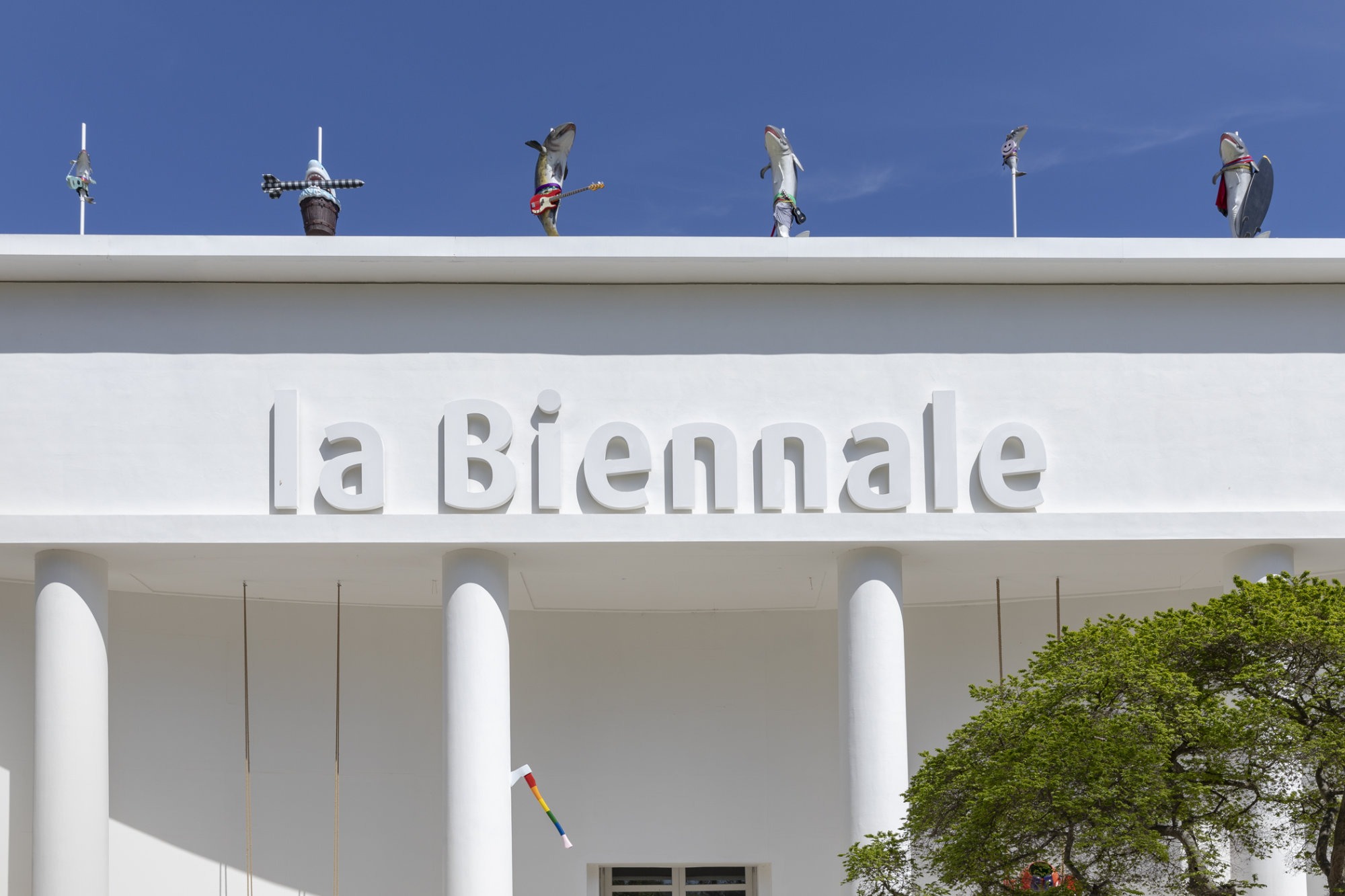
WHAT IF THEY BARK 01-07, 2022
Glass reinforced plastic (GRP), wool fabric, scarfs, steel base, ukulele, chains,
Variable dimensions:
2 sharks with rockets, 100 × 100 × 70 cm each.
3 large mackerels, 190 × 130 × 120 cm each.
2 small mackerels, 110 × 60 × 50 cm each
59th International Art Exhibition – La Biennale di Venezia, The Milk of Dreams
All works with the additional support of Petzel Gallery, New York; Institut fur Auslandsbeziehungen – ifa
Photo: Roberto Marossi
Courtesy: La Biennale di Venezia
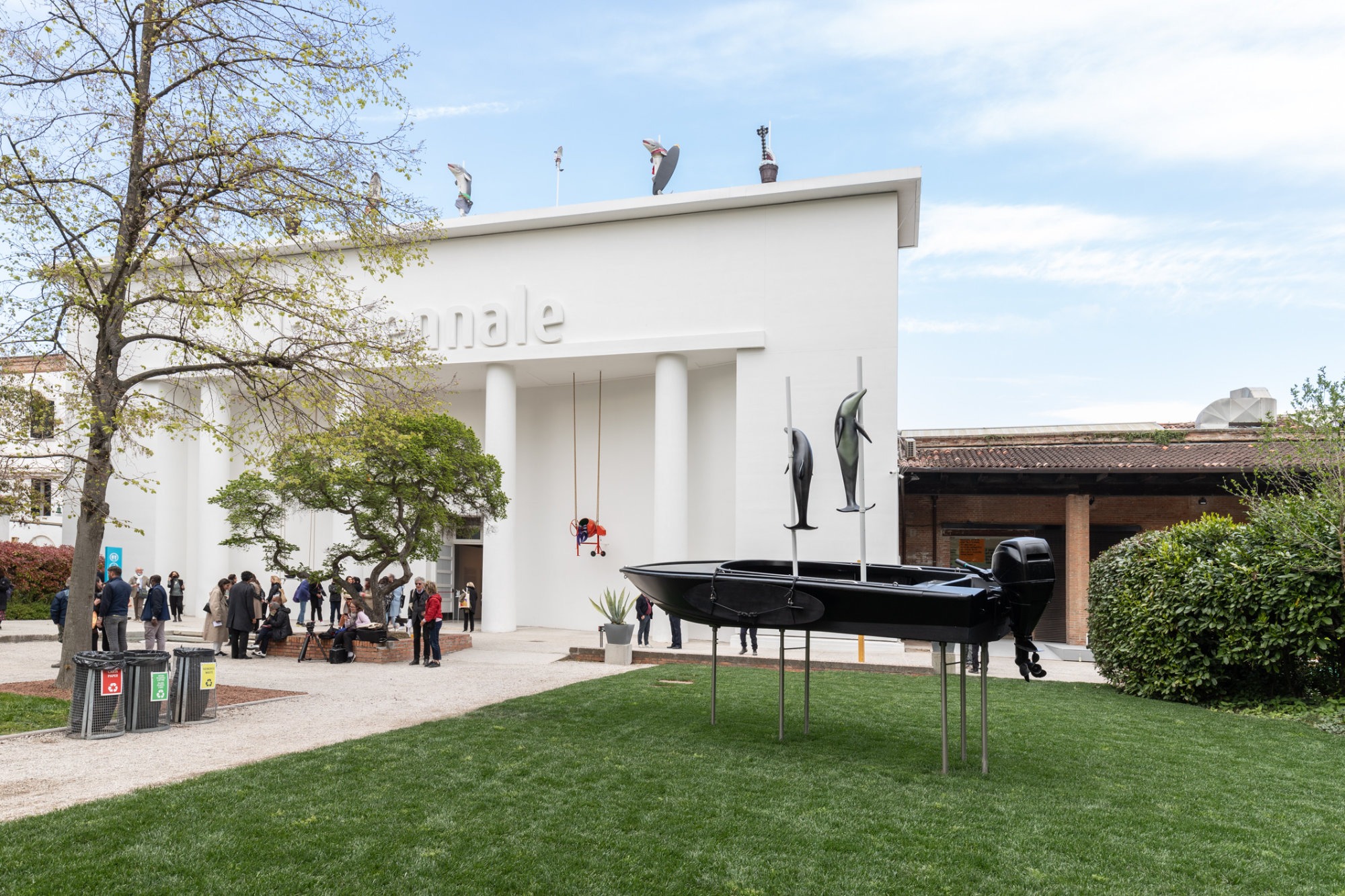
VENICE 1984, 2022
Painted steel, boat motor, glass reinforced plastic, steel
250 × 300 × 75 cm
59th International Art Exhibition – La Biennale di Venezia, The Milk of Dreams
With the additional support of Petzel Gallery, New York; Institut fur Auslandsbeziehungen – ifa
Photo: Marco Cappelletti
Courtesy: La Biennale di Venezia
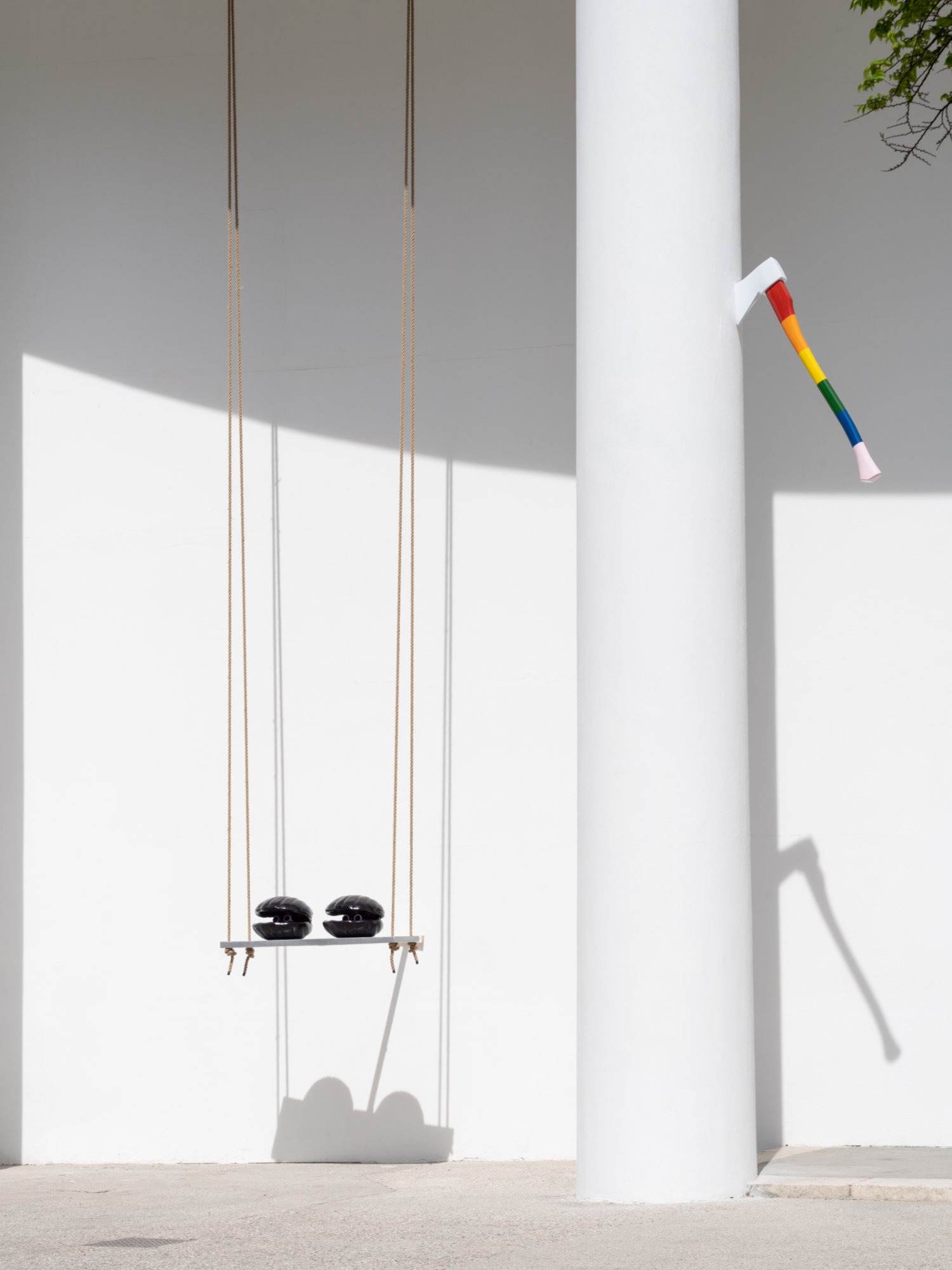
HERMIT CRAB (GLASS VERSION), 2022, Steel cement mixer, epoxy resin, rubber, 140 × 140 × 100 cm
AXE, 2022, Wood, steel, synthetic resin varnish, 100 × 45 × 9 cm
All works with the additional support of Petzel Gallery, New York; Institut fur Auslandsbeziehungen – ifa
59th International Art Exhibition – La Biennale di Venezia, The Milk of Dreams
Photo: Marco Cappelletti
Courtesy: La Biennale di Venezia
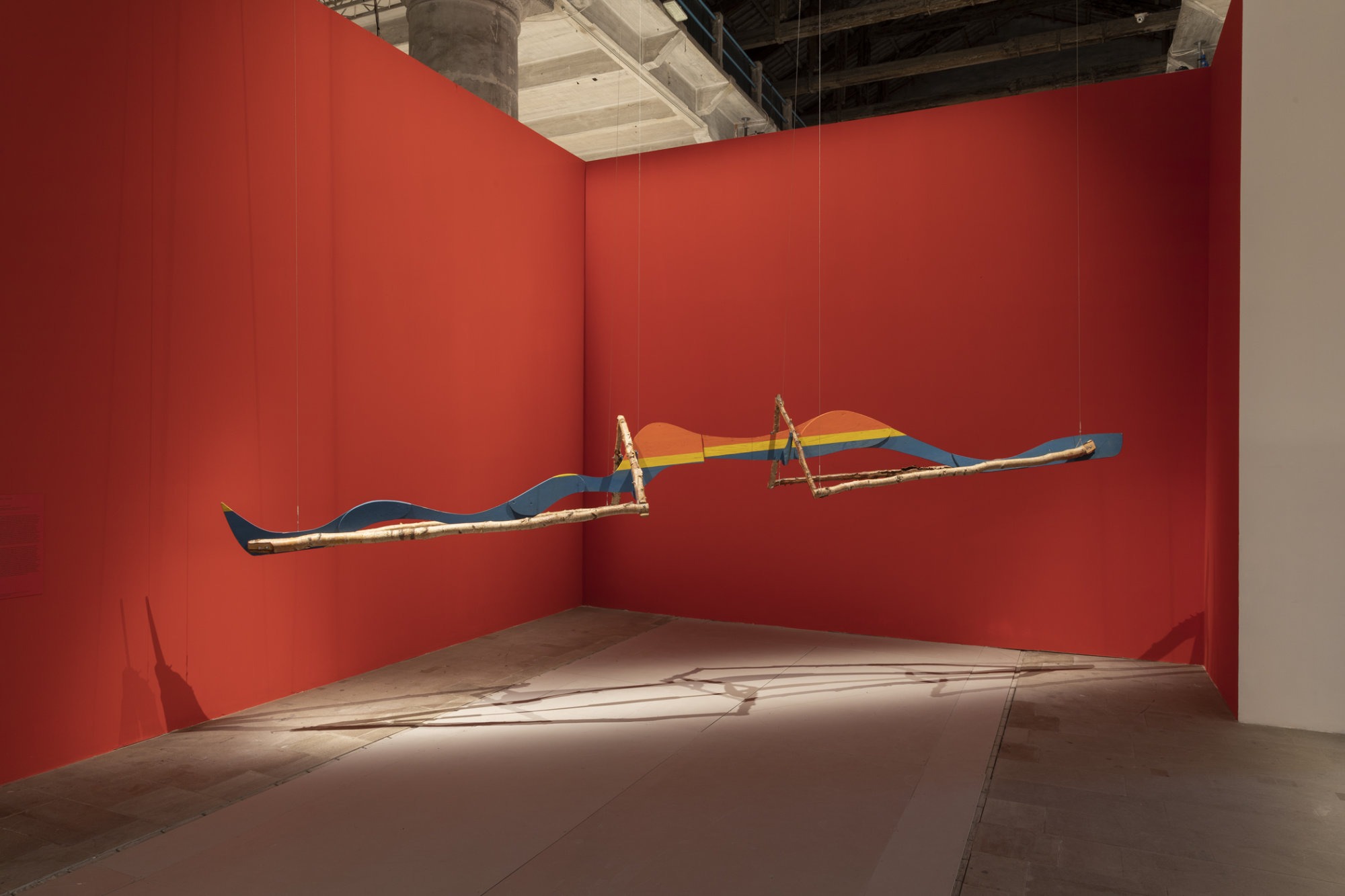
Sculpture I & II, 1979
Wood, paint, screws, and wires
62 × 78 × 274 cm and 65 × 75 × 298 cm
Nordnorsk Kunstmuseum, Tromso, Norway
With the additional support of Office for Contemporary Art Norway (OCA)
59th International Art Exhibition – La Biennale di Venezia, The Milk of Dreams
Photo: Roberto Marossi
Courtesy: La Biennale di Venezia

Introspection II—Machines,
Tools & Weapons, 1969–1972
Monoprint
101.6 × 626.75 cm
Introspection II—Machines, Tools & Weapons maps the growth of technology through the ages from the first manmade tools to the technical sophistication of the twentieth century and concludes with the Human Hang-Up Machine.
59th International Art Exhibition – La Biennale di Venezia, The Milk of Dreams
Photo: Marco Cappelletti
Courtesy: La Biennale di Venezia
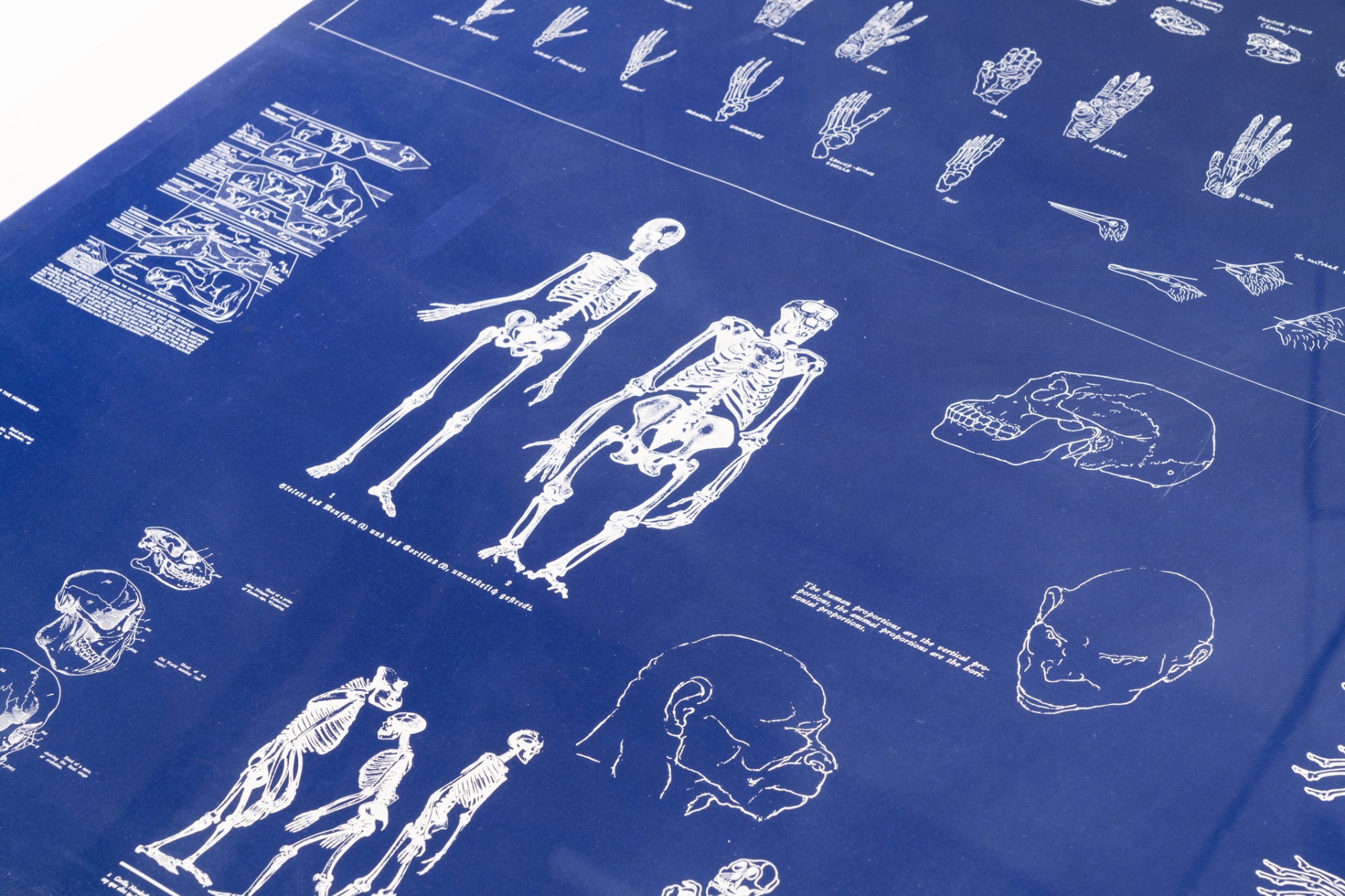
Introspection I—Evolution, 1968–1971
Monoprint
107.63 × 542.29 cm
Introspection I—Evolution portrays evolutionary developments from the Psychozoic Era and the separation of man and ape to the development of intelligence and the beginnings of knowledge,
science and art. It investigates comparative anatomy, genetics, physics, biology, cytology, heredity, anatomy, mutation, environmental awareness, logical and social relations, analogous surfaces, genealogy, cartography, communication, astronomy, time studies, linguistics, X-ray technology, time measurements, and art.
59th International Art Exhibition – La Biennale di Venezia, The Milk of Dreams
Photo: Marco Cappelletti
Courtesy: La Biennale di Venezia
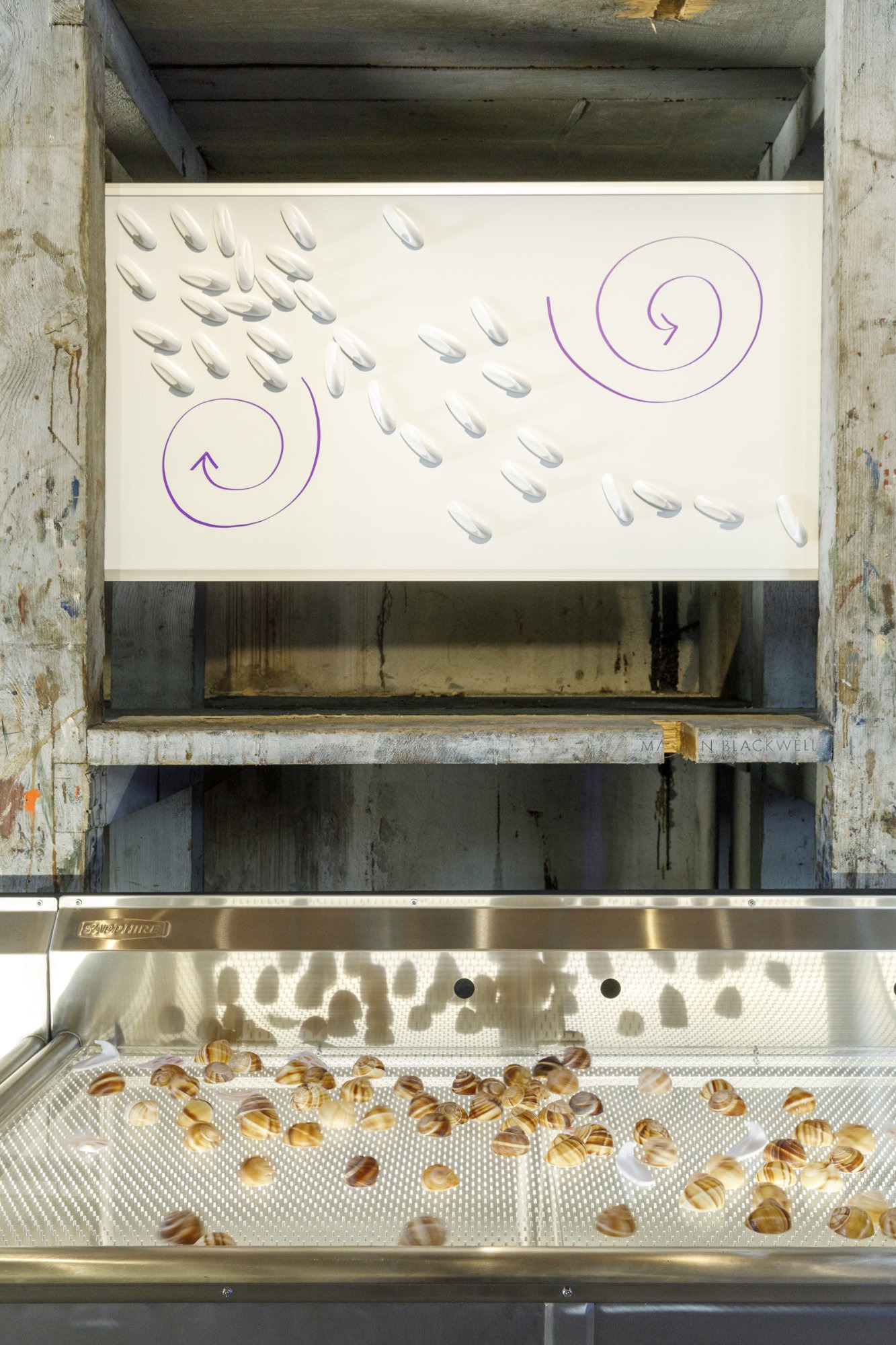
Sink or Float, 2022
Mixed-media installation
Dimensions variable
With the additional support of The Agency for Cultural Affairs, Government of Japan (Bunka-cho Art Platform Japan);
Take Ninagawa, Tokyo; Bortolami, New York
59th International Art Exhibition – La Biennale di Venezia, The Milk of Dreams
Photo: Roberto Marossi
Courtesy: La Biennale di Venezia

Sink or Float, 2022
Mixed-media installation
Dimensions variable
With the additional support of The Agency for Cultural Affairs, Government of Japan (Bunka-cho Art Platform Japan);
Take Ninagawa, Tokyo; Bortolami, New York
59th International Art Exhibition – La Biennale di Venezia, The Milk of Dreams
Photo: Roberto Marossi
Courtesy: La Biennale di Venezia
The Milk of Dreams
Artistic Director: Cecilia Alemani
The Milk of Dreams takes its title from a book by Leonora Carrington (1917–2011) in which the Surrealist artist describes a magical world where life is constantly re-envisioned through the prism of the imagination. It is a world where everyone can change, be transformed, become something or someone else; a world set free, brimming with possibilities. But it is also the allegory of a century that imposed intolerable pressure on the very definition of the self, forcing Carrington into a life of exile: locked up in mental hospitals, an eternal object of fascination and desire, yet also a figure of startling power and mystery, always fleeing the strictures of a fixed, coherent identity. When asked about her birth, Carrington would say she was the product of her mother’s encounter with a machine, suggesting the same bizarre union of human, animal, and mechanical that marks much of her work.
The exhibition The Milk of Dreams takes Leonora Carrington’s otherworldly creatures, along with other figures of transformation, as companions on an imaginary journey through the metamorphoses of bodies and definitions of the human.
This exhibition is grounded in many conversations with artists held in the last few years. The questions that kept emerging from these dialogues seem to capture this moment in history when the very survival of the species is threatened, but also to sum up many other inquiries that pervade the sciences, arts, and myths of our time. How is the definition of the human changing? What constitutes life, and what differentiates plant and animal, human and non-human? What are our responsibilities towards the planet, other people, and other life forms? And what would life look like without us?
These are some of the guiding questions for this edition of the Biennale Arte, which focuses on three thematic areas in particular: the representation of bodies and their metamorphoses; the relationship between individuals and technologies; the connection between bodies and the Earth.
Many contemporary artists are imagining a posthuman condition that challenges the modern Western vision of the human being − and especially the presumed universal ideal of the white, male “Man of Reason” − as fixed centre of the universe and measure of all things. In its place, artists propose new alliances between species, and worlds inhabited by porous, hybrid, manifold beings that are not unlike Carrington’s extraordinary creatures. Under the increasingly invasive pressure of technology, the boundaries between bodies and objects have been utterly transformed, bringing about profound mutations that remap subjectivities, hierarchies, and anatomies.
Today, the world seems dramatically split between technological optimism − which promises that the human body can be endlessly perfected through science − and the dread of a complete takeover by machines via automation and artificial intelligence. This rift has widened during the Covid-19 pandemic, which has forced us even further apart and caged much of human interaction behind the screens of electronic devices.
The pressure of technology, the heightening of social tensions, the outbreak of the pandemic, and the looming threat of environmental disaster remind us every day that as mortal bodies, we are neither invincible nor self-sufficient, but rather part of a symbiotic web of interdependencies that bind us to each other, to other species, and to the planet as a whole.
In this climate, many artists envision the end of anthropocentrism, celebrating a new communion with the non-human, with the animal world, and with the Earth; they cultivate a sense of kinship between species and between the organic and inorganic, the animate and inanimate. Others react to the dissolution of supposedly universal systems, rediscovering localised forms of knowledge and new politics of identity. Still others practice what feminist theorist and activist Silvia Federici calls the “re-enchantment of the world”, mingling indigenous traditions with personal mythologies in much the same way as Leonora Carrington.
Exhibition Structure and Time Capsules
The exhibition unfolds in the Central Pavilion of the Giardini, and in the Corderie, Artiglierie, and the outdoor spaces of the Gaggiandre and Giardino delle Vergini at the Arsenale complex.
The Milk of Dreams includes over two hundred artists from 58 countries. More than 180 of these artists have never been in the International Art Exhibition until now. For the first time in its 127-year history, the Biennale will include a majority of women and gender non-conforming artists, a choice that reflects an international art scene full of creative ferment and a deliberate rethinking of man’s centrality in the history of art and contemporary culture.
The exhibition features contemporary works and new projects conceived specifically for the Biennale Arte, presented in dialogue with historic works from the 19th century on.
As visitors move through the exhibition in the Central Pavilion and the Corderie, they encounter five smaller, historical sections: miniature constellations of artworks, found objects, and documents, clustered together to explore certain key themes. Conceived like time capsules, these shows within the show provide additional tools of investigation and introspection, weaving a web of references and echoes that link artworks of the past – including major museum loans and unconventional selections – to the pieces by contemporary artists in the surrounding space.
This wide-ranging, transhistorical approach traces kinships and affinities between artistic methods and practices, even across generations, to create new layers of meaning and bridge present and past. What emerges is a historical narrative that is not built around systems of direct inheritance or conflict, but around forms of symbiosis, solidarity, and sisterhood.
With a specific choreography of architectural spaces developed in collaboration with the design duo Formafantasma, these “cabinets” also prompt reflection on how the history of art is constructed around museum and exhibition practices that establish hierarchies of taste and mechanisms of inclusion and exclusion. Many of the stories told in these capsules have not yet been absorbed into the official canon and have been for too long considered minor and obscure.
These sections thus participate in the complex process of rewriting and rereading history that has marked the last few years, when it has become clearer than ever that no historical narrative can ever be considered final.
The Artists in the Exhibition
The fulcrum of The Milk of Dreams is a gallery on the lower level of the Central Pavilion where the first of the five capsules features a collection of artworks by women artists of the historical avant-garde movements, including, among others, Eileen Agar, Leonora Carrington, Claude Cahun, Leonor Fini, Ithell Colquhoun, Loïs Mailou Jones, Carol Rama, Augusta Savage, Dorothea Tanning, and Remedios Varo. The works of these and other women artists of the early 20th century – shown in an ensemble inspired by Surrealist exhibitions – summon up a domain of the marvellous where anatomies and identities can shift and change, following the desire for transformation and emancipation.
Many of the same lines of thought return in the work of contemporary artists on view in the other galleries of the Central Pavilion. The mutant bodies convoked by Aneta Grzeszykowska, Julia Phillips, Ovartaci, Christina Quarles, Shuvinai Ashoona, Sara Enrico, Birgit Jürgenssen, and Andra Ursuţa suggest new mergers of the organic and the artificial, whether as a means of self-reinvention or as a disquieting foretaste of an increasingly dehumanised future.
The ties between human being and machine are analysed in many of the works on view, as in those by Agnes Denes, Lillian Schwartz, and Ulla Wiggen, for instance, or the screen-like surfaces by Dadamaino, Laura Grisi, and Grazia Varisco, collected in a second historical presentation that explores Programmed Art and kinetic abstraction in the 1960s.
The bonds between body and language are at the heart of another capsule inspired by Materializzazione del linguaggio, a showcase of Visual and Concrete Poetry at Biennale Arte 1978 that was one of the first openly feminist exhibitions in the institution’s history. Visual and concrete poems by Mirella Bentivoglio, Tomaso Binga, Ilse Garnier, Giovanna Sandri, and Mary Ellen Solt are juxtaposed here with experiments in automatic writing and mediumistic communication by Eusapia Palladino, Georgiana Houghton, and Josefa Tolrà, and other forms of “feminine writing” that range from Gisèle Prassinos’s tapestries to Unica Zürn’s micrographies.
Signs, symbols, and private languages also crop up in the work of contemporary artists such as Bronwyn Katz, Sable Elyse Smith, Amy Sillman, and Charline von Heyl, while Jacqueline Humphries’ typographic paintings are juxtaposed with Carla Accardi’s graphemes and with the machine code that informs the art of Charlotte Johannesson, Vera Molnár, and Rosemarie Trockel.
In contrast with these hypertechnological scenarios, the paintings and assemblages by Paula Rego and Cecilia Vicuña envision new forms of symbiosis between animals and human beings, while Merikokeb Berhanu, Mrinalini Mukherjee, Simone Fattal, and Alexandra Pirici craft narratives that interweave environmental concerns with ancient chthonic deities, yielding innovative ecofeminist mythologies.
The exhibition at the Arsenale opens with the work of Belkis Ayón, an artist whose work draws on Afro-Cuban traditions to describe an imaginary matriarchal society. The rediscovery of art’s myth-making potential can also be seen in Ficre Ghebreyesus’ large-scale paintings and Portia Zvavahera’s hallucinatory visions, as well as in the allegorical compositions by Frantz Zéphirin and Thao Nguyen Phan that blend histories, dreams, and religions. Drawing on indigenous knowledge and subverting colonialist stereotypes, Argentine artist Gabriel Chaile presents a new series of monumental sculptures, made from unfired clay, which tower like the idols of a fanciful Mesoamerican culture.
Many artists in the exhibition imagine complex new relationships with the planet and with nature, suggesting unprecedented ways to coexist with other species and with the environment. Eglė Budvytytė’s video tells the story of a group of young people lost in the forests of Lithuania, while the characters in a new video by Zheng Bo live in total – even sexual – communion with nature. A similar sense of wonder can be found in the snowy scenes embroidered by Sámi artist Britta Marakatt-Labba, and ancient traditions also overlap with new forms of ecological activism in works by Sheroanawe Hakihiiwe and in Jaider Esbell’s dreamlike compositions.
The Corderie starts off with another time capsule, in this case inspired by sci-fi author Ursula K. Le Guin and her theory of fiction, which links the birth of civilisation not to the invention of weapons, but to tools used for providing sustenance and care: bags, sacks, and vessels. In this section, ovoid carapaces by Surrealist artist Bridget Tichenor are juxtaposed with Maria Bartuszová’s plaster sculptures, Ruth Asawa’s hanging sculptures, and Tecla Tofano’s hybrid creatures. These works from the past live side-by-side with Magdalene Odundo’s anthropomorphic vases and Pinaree Sanpitak’s concave forms, while video artist Saodat Ismailova surveys underground isolation cells that serve as places of refuge and meditation.
Colombian artist Delcy Morelos, whose works are inspired by Andean cosmologies and the cultures of the Amazon, presents a large-scale installation featuring a maze built out of earth. Many other artists in the show combine political and social approaches with an investigation of local traditions, as in Prabhakar Pachpute’s large-scale paintings of the environmental devastation caused by the mining industry in India, or Ali Cherri’s video about the dams of the Nile. Igshaan Adams grounds his abstract textile compositions in themes ranging from apartheid to gender conditions in South Africa, whereas Ibrahim El-Salahi conveys his experience of illness and his relationship with the pharmaceutical world through a meditative practice of meticulous daily drawings.
The final section at the Corderie is introduced by the fifth and last time capsule, revolving around the figure of the cyborg. This presentation brings together artists working over the course of the 20th century who imagined new fusions of the human and the artificial, as harbingers of a posthuman, postgender future. This capsule includes artworks, artefacts, and documents from early 20th-century artists such as the Dadaist Elsa von Freytag-Loringhoven, Bauhaus photographers Marianne Brandt and Karla Grosch, and Futurists Alexandra Exter, Giannina Censi, and Regina. Here, Anu Põder’s delicate sculptures portray fragmented bodies that stand in contrast with Louise Nevelson’s monoliths, Liliane Lijn’s totems, Rebecca Horn’s machines, and Kiki Kogelnik’s robots.
At the very end of the Corderie, after moving through a vast, diaphanous installation by Kapwani Kiwanga, the exhibition takes on colder, more artificial tones and the human figure becomes increasingly evanescent, replaced by animals and hybrid or robotic creatures. Marguerite Humeau’s biomorphic sculptures resemble cryogenic beings, juxtaposed with Teresa Solar’s monumental exoskeletons. Raphaela Vogel describes a world where animals have won out over humans, while Jes Fan’s sculptures use organic materials like melanin and breast milk to create a new kind of bacterial culture.
Apocalyptic scenarios of cells run wild and nuclear nightmares also turn up in drawings by Tatsuo Ikeda and in Mire Lee’s installations, agitated by the twitching of machineries that resemble the digestive system of some animal. A new video by posthumanist pioneer Lynn Hershman Leeson celebrates the birth of artificial organisms, while Korean artist Geumhyung Jeong plays with bodies that have become completely robotic and can be reassembled at whim.
Other works hover between obsolete technology and mirage-like visions of the future. Zhenya Machneva’s abandoned factories and decrepit industrial mechanisms seem brought back to life in the installations by Monira Al Qadiri and Dora Budor, which whir and spin like bachelor machines. Capping off this series of devices gone haywire, a large installation by Barbara Kruger conceived specifically for the Corderie combines slogans, poetry, and word-objects in a crescendo of hypercommunication. In contrast, Robert Grosvenor’s silent sculptures reveal a world that seems devoid of all human presence. And beyond this motionless universe grows Precious Okoyomon’s vast entropic garden, swarming with new life.
Winding up the exhibition in the outdoor spaces at the Arsenale are major projects by Giulia Cenci, Virginia Overton, Solange Pessoa, Wu Tsang, and Marianne Vitale, which guide viewers to the Giardino delle Vergini along a path that leads through animal beings, organic sculptures, industrial ruins, and disorienting landscapes.
The Milk of Dreams was conceived and organised in a period of enormous instability and uncertainty, since its development coincided with the outbreak and spread of the Covid-19 pandemic. La Biennale di Venezia was forced to postpone this edition by one year, an event that had only occurred during the two World Wars since 1895. So the very fact that this exhibition can open is somewhat extraordinary: its inauguration is not exactly the symbol of a return to normal life, but rather the outcome of a collective effort that seems almost miraculous. For the first time, except perhaps in the postwar period, the Artistic Director was not able to view many of the artworks first-hand, or meet in person with most of the participating artists.
During these endless months in front of the screen, I have pondered the question of what role the International Art Exhibition should play at this historical juncture, and the simplest, most sincere answer I could find is that the Biennale sums up all the things we have so sorely missed in the last two years: the freedom to meet people from all over the world, the possibility of travel, the joy of spending time together, the practice of difference, translation, incomprehension, and communion.
The Milk of Dreams is not an exhibition about the pandemic, but it inevitably registers the upheavals of our era. In times like this, as the history of La Biennale di Venezia clearly shows, art and artists can help us imagine new modes of coexistence and infinite new possibilities of transformation.
Biennale Arte 2022 Participants
GIARDINI
THE WITCH'S CRADLE
Whether by evoking nature, escaping into fantasy, or by using their own bodies to model new possibilities, each of these artists employs self-metamorphosis as an answer to the male-dominated constructions governing identity.
EILEEN AGAR
GERTRUD ARNDT
JOSEPHINE BAKER
BENEDETTA
CLAUDE CAHUN
LEONORA CARRINGTON
ITHELL COLQUHOUN
VALENTINE DE SAINT-POINT
LISE DEHARME AND RACHILDE
MAYA DEREN
EDITH RIMMINGTON
LEONOR FINI
JANE GRAVEROL
FLORENCE HENRI
LOÏS MAILOU JONES
IDA KAR
ANTOINETTE LUBAKI
BAYA MAHIEDDINE
NADJA
AMY NIMR
MERET OPPENHEIM
VALENTINE PENROSE
ALICE RAHON
ENIF ROBERT
CENTRAL PAVILION
ROSA ROSÀ
AUGUSTA SAVAGE
DOROTHEA TANNING
TOYEN
REMEDIOS VARO
META VAUX WARRICK FULLER
LAURA WHEELER WARING
MARY WIGMAN
CORPS ORBITE
Conceived, in part, as a response to Mirella Bentivoglio’s Materializzazione del linguaggio exhibition, this display gathers artists and writers spanning the 19th and 20th centuries who employ expanded forms of textual production as tools for emancipation and the practice of difference.
DJUNA BARNES
MIRELLA BENTIVOGLIO IN COLLABORATION WITH ANNALISA ALLOATTI
TOMASO BINGA
MILLY CANAVERO
MINNIE EVANS
ILSE GARNIER
LINDA GAZZERA
GEORGIANA HOUGHTON
MINA LOY
JOYCE MANSOUR
SISTER GERTRUDE MORGAN
EUSAPIA PALLADINO
ALICE RAHON
GIOVANNA SANDRI
HÉLÈNE SMITH
MARY ELLEN SOLT
JOSEFA TOLRÀ
UNICA ZÜRN
TECHNOLOGIES OF ENCHANTMENT
The artists in this presentation bring somatic complexity to “programmed” artistic creation. Whether employing actual industrial materials and technologies, each artist included here works on the boundaries between technology and the self.
MARINA APOLLONIO
DADAMAINO
LUCIA DI LUCIANO
LAURA GRISI
GRAZIA VARISCO
NANDA VIGO
A LEAF A GOURD A SHELL A NET A BAG A SLING A SACK A BOTTLE A POT A BOX A CONTAINER
Taking up Ursula K. Le Guin’s potent metaphor, this display is conceived as an iconology of vessels in various forms – including nets, bags, eggs, shells, bowls, and boxes – and their symbolic, spiritual, or metaphorical links to nature and the body, whether realised in bag-like sculptural shapes, volumetric ceramics, or scientific explorations of bodily reproduction.
RUTH ASAWA
MARIA BARTUSZOVÁ
REGINA CASSOLO BRACCHI
GIANNINA CENSI
ANNA COLEMAN LADD
ALETTA JACOBS
MARUJA MALLO
MARIA SIBYLLA MERIAN
SOPHIE TAEUBER-ARP
TOSHIKO TAKAEZU
BRIDGET TICHENOR
TECLA TOFANO
SEDUCTION OF THE CYBORG
This presentation takes up Donna Haraway’s framework to consider the included artists as cyborgs: hybrid bodies whose work engages concepts of the self that are extended, relational, or prosthetic – including, but also beyond, the idea of an engineered prosthesis.
MARIANNE BRANDT
ALEXANDRA EXTER
KARLA GROSCH
FLORENCE HENRI
HANNAH HÖCH
REBECCA HORN
KIKI KOGELNIK
LILIANE LIJN
LOUISE NEVELSON
ANU PÕDER
LAVINIA SCHULZ E WALTER HOLDT
SOPHIE TAEUBER-ARP
MARIE VASSILIEFF
THE MILK OF DREAMS
The Exhibition takes place in the Central Pavilion (Giardini) and in the Arsenale.
ARSENALE
NOOR ABUARAFEH
CARLA ACCARDI
MONIRA AL QADIRI
ÖZLEM ALTIN
SHUVINAI ASHOONA
BELKIS AYÓN
FIRELEI BÁEZ
FELIPE BAEZA
MERIKOKEB BERHANU
COSIMA VON BONIN
LOUISE BONNET
KERSTIN BRÄTSCH
DORA BUDOR
EGLĖ BUDVYTYTĖ
in collaboration with
MARIJA OLŠAUSKAITĖ
and JULIJA STEPONAITYTĖ
LIV BUGGE
SIMNIKIWE BUHLUNGU
MIRIAM CAHN
ELAINE CAMERON-WEIR
AMBRA CASTAGNETTI
GIULIA CENCI
GABRIEL CHAILE
ALI CHERRI
MYRLANDE CONSTANT
JUNE CRESPO
NOAH DAVIS
LENORA DE BARROS
SONIA DELAUNAY
AGNES DENES
IBRAHIM EL-SALAHI
SARA ENRICO
CHIARA ENZO
ANDRO ERADZE
JANA EULER
JADÉ FADOJUTIMI
JES FAN
SAFIA FARHAT
SIMONE FATTAL
CÉLESTIN FAUSTIN
KATHARINA FRITSCH
AAGE GAUP
FICRE GHEBREYESUS
ELISA GIARDINA PAPA
ROBERTO GIL DE MONTES
NAN GOLDIN
ROBERT GROSVENOR
ANETA GRZESZYKOWSKA
SHEROANAWE HAKIHIIWE
LYNN HERSHMAN LEESON
CHARLINE VON HEYL
JESSIE HOMER FRENCH
SHEREE HOVSEPIAN
TISHAN HSU
JACQUELINE HUMPHRIES
KUDZANAI-VIOLET HWAMI
ADAMS IGSHAAN
TATSUO IKEDA
SAODAT ISMAILOVA
GEUMHYUNG JEONG
CHARLOTTE JOHANNESSON
JAMIAN JULIANO-VILLANI
BIRGIT JÜRGENSSEN
ALLISON KATZ
BRONWYN KATZ
KAPWANI KIWANGA
BARBARA KRUGER
TETSUMI KUDO
LOUISE LAWLER
CAROLYN LAZARD
MIRE LEE
SIMONE LEIGH
HANNAH LEVY
TAU LEWIS
SHUANG LI
CANDICE LIN
LUYANG
GABRIELLE L’HIRONDELLE HILL
ZHENYA MACHNEVA
BRITTA MARAKATT-LABBA
DIEGO MARCON
SIDSEL MEINECHE HANSEN
VERA MOLNÁR
DELCY MORELOS
SANDRA MUJINGA
MRINALINI MUKHERJEE
MAGDALENE ODUNDO
PRECIOUS OKOYOMON
OVARTACI
AKOSUA ADOMA OWUSU
PRABHAKAR PACHPUTE
VIOLETA PARRA
ROSANA PAULINO
ELLE PÉREZ
SONDRA PERRY
SOLANGE PESSOA
THAO NGUYEN PHAN
JULIA PHILLIPS
JOANNA PIOTROWSKA
ALEXANDRA PIRICI
CHRISTINA QUARLES
JANIS RAFA
PAULA REGO
LUIZ ROQUE
NIKI DE SAINT PHALLE
ARSENALE
PINAREE SANPITAK
AKI SASAMOTO
LILLIAN SCHWARTZ
AMY SILLMAN
ELIAS SIME
MARIANNA SIMNETT
SABLE ELYSE SMITH
TERESA SOLAR
P. STAFF
EMMA TALBOT
TOURMALINE
ROSEMARIE TROCKEL
WU TSANG
KAARI UPSON
ANDRA URSUŢA
SANDRA VÁSQUEZ DE LA HORRA
CECILIA VICUÑA
MARIANNE VITALE
RAPHAELA VOGEL
ULLA WIGGEN
MÜGE YILMAZ
FRANTZ ZÉPHIRIN
ZHENG BO
PORTIA ZVAVAHERA
NATIONAL PAVILIONS
ALBANIA
Lumturi Blloshmi
Curator: Adela Demetja
ARGENTINA
Mónica Heller
Curator: Alejo Ponce de León
ARMENIA
Andrius Arutiunian
Curators: Anne Davidian, Elena Sorokina
AUSTRALIA
Marco Fusinato
Curator: Alexie Glass-Kantor
AUSTRIA
Jakob Lena Knebl and Ashley Hans Scheirl
Curator: Karola Kraus
AZERBAIJAN
Zhuk, Infinity, Ramina Saadatkhan, Fidan Novruzova, Fidan Akhundova, Sabiha Khankishiyeva, Agdes Baghirzade
Curator: Emin Mammadov
BANGLADESH
Jamal Uddin Ahmed, Mohammad Iqbal, Harun-Ar-Rashid, Sumon Wahed, Promity Hossain, Mohammad Eunus, Marco Cassarà, Franco Marrocco, Giuseppe Diego Spinelli
Venue: Palazzo Pisani Revedin, San Marco 4013
Curator: Viviana Vannucci
BELGIUM
Francis Alÿs
Curator: Hilde Teerlinck
BOLIVIA
Artspace4rent, Cannaregio 4120
Curator/Exhibitor: Warmichacha
BRASIL
Jonathas de Andrade
Curator: Jacopo Crivelli Visconti
BULGARIA
Michail Michailov
Curator: Irina Batkova
CAMEROON
Francis Nathan Abiamba (Afran), Angéle Etoundi Essamba, Justine Gaga, Salifou Lindou, Shay Frisch, Umberto Mariani, Matteo Mezzadri, Jorge R. Pombo, NFT (Kevin Abosch, João Angelini, Marco Bertìn (Berxit), Cryptoart Driver, Lana Denina, Alberto Echegaray Guevara, Genesis People, Joachim Hildebrand, Meng Huang, Eduardo Kac, Giulia Kosice, Julio Le Parc, Marina Nuñez, Miguel Soler-Roig, Miguel Ángel Vidal, Burkhard von Harder, Gabe Weis, Clark Winter, Shavonne Wong, Wang Xing, Alessandro Zannier, ZZH)
Curators: Paul Emmanuel Loga Mahop, Sandro Orlandi Stagl
CANADA
Stan Douglas
Reid Shier
CHILE
Ariel Bustamante, Carla Macchiavello, Dominga Sotomayor, Alfredo Thiermann
Curator: Camila Marambio
CHINA
Liu Jiayu, Wang Yuyang, Xu Lei, AT Group (Central Academy of Fine Arts [CAFA] Institute of Sci-Tech Arts+Tsinghua Laboratory of Brain and Intelligence [TLBI] Group Project)
Curator: Zhang Zikang
COREA
Yunchul Kim
Youngchul Lee
CROATIA
Tomo Savić-Gecan
Curator: Elena Filipovic
CUBA
Rafael Villares, Kcho, Giuseppe Stampone
Curator: Nelson Ramirez de Arellano Conde
EGYPT
Mohamed Shoukry, Weaam El Masry, Ahmed El Shaer
Curator: Mohamed Shoukry
ESTONIA
Kristina Norman, Bita Ravazi
Curator: Corina L Apostol
PHILIPPINES
Gerardo Tan, Felicidad A.Prudente and Sammy N. Buhle
Curators: Yael Buencamino Borromeo and Arvin Flores
FINLAND
Pilvi Takala
Curator: Christina Li
FRANCE
Zineb Sedira
Curators: Yasmina Reggad, Sam Bardaouil and Till Fellrath
GEORGIA
Mariam Natroshvili, Detu Jincharadze
Curators: Vato Urushadze, Khatia Tchokhonelidze, Giorgi Spanderashvili
GERMANY
Maria Eichorn
Curator: Yilmaz Dziewior
GHANA
Na Chainkua Reindorf, Diego Araúja, Afroscope
Curator: Nana Oforiatta Ayim
GREAT BRITAIN
Sonia Boyce
Curator: Emma Ridgway
LUXEMBOURG
Tina Gillen
Christophe Gallois
GREECE
Loukia Alavanou
Curator: Heinz Peter Schwerfel
GRENADA
Cypher Art Collective of Grenada: Oliver Benoit, Billy Gerard Frank, Ian Friday, Asher Mains, Susan Mains, Angus Martin, Samuel Ogilvie; Giancarlo Flati; Identity Collective; Anna Maria Li Gotti; Nino Perrone; Rossella Pezzino de Geronimo; Marialuisa Tadei
Curator: Daniele Radini Tedeschi
GUATEMALA
Curator/Exhibitor: Christian Escobar
HUNGARY
Zsófia Keresztes
Curator: Mónika Zsikla
ICELAND
Sigurdur Gudjonsson
Curator: Mónica Bello
IRELAND
Niamh O’Malley
Curators: Temple Bar Gallery + Studios
ISRAEL
Ilit Azoulay
Curator: Shelley Harten
ITALY
Gian Maria Tosatti
Curator: Eugenio Viola
IVORY COAST
Frédéric Bruly Bouabré, Abdoulaye Diarrassouba dit Aboudia, Armand Boua, Saint-Etienne Yéanzi dit Yeanzi, Laetitia Ky, Aron Demetz
Curators: Massimo Scaringella, Alessandro Romanini
KAZAKHSTAN
Curator/Exhibitor: ORTA collective (Alexandra Morozova, Rusten Begenov, Darya Jumelya, Alexander Bakanov, Sabina Kuangaliyeva)
KENYA
Dickens Otieno, Syowia Kyambi, Kaloki Nyamai, Wanja Kimani
Curator: Jimmy Ogonga
KOSOVO
Jakup Ferri
Curator: Inke Arns
KYRGYZSTAN
Firouz Farman Farmaian
Curator: Janet Rady
LATVIA
Skuja Braden (Ingūna Skuja and Melissa D. Braden)
Curators: Solvita Krese and Andra Silapētere
LEBANON
Ayman Baalbaki and Danielle Arbid
Curator: Nada Ghandour
LITHUANIA
Robertas Narkus
Curator: Neringa Bumblienė
MALTA
Arcangelo Sassolino, Giuseppe Schembri Bonaci, Brian Schembri
Curators: Keith Sciberras, Jeffrey Uslip
MEXICO
Mariana Castillo Deball, Naomi Rincón Gallardo, Fernando Palma Rodríguez, and Santiago Borja Charles
Curators: Catalina Lozano and Mauricio Marcin
MONGOLIA
Munkhtsetseg Jalkhaajav
Curator: Gantuya Badamgarav
MONTENEGRO
Dante Buu, Lidija Delić & Ivan Šuković, Darko Vučković, Jelena Tomašević, Art Collection of Non-Aligned Countries (Zuzana Chalupova, Rene Portocarrero, unknown author from Iraq and Bernard Matemera)
Curator: Natalija Vujošević
NAMIBIA
Renn
Curator: Marco Furio Ferrario
NEPAL
Ang Tsherin Sherpa (also known as) Tsherin Sherpa
Hit Man Gurung, Sheelasha Raj Bhandari
NETHERLANDS
Melanie Bonajo
Curators: Orlando Maaike Gouwenberg, Geir Haraldseth, Soraya Pol
NORTH MACEDONIA
Robert Jankuloski, Monika Moteska
Curators: Ana Frangovska, Sanja Kojic Mladenov
NEW ZEALAND
Yuki Kihara
Curator: Natalie King
OMAN
Anwar Sonja, Hassan Meer, Budoor Al Riyami, Radhika Al Khimji, Raiya Al Rawahi
Curator: Aisha Stoby
THE NORDIC PAVILION
NORWAY, FINLAND, SWEDEN
The Sami Pavilion
Pauliina Feodoroff, Máret Ánne Sara, Anders Sunna
Curators: Katya García-Antón, Liisa-Rávná Finborg and Beaska Niillas
PERÙ
Herbert Rodriguez
Curators: Jorge Villacorta, Viola Varotto
POLAND
Małgorzata Mirga-Tas
Curators: Wojciech Szymański and Joanna Warsza
PORTUGAL
Pedro Neves Marques
Curators: João Mourão/Luís Silva
ROMANIA
Adina Pintilie
Curator: Cosmin Costinas and Viktor Neumann
SAN MARINO
Elisa Cantarelli, Nicoletta Ceccoli, Roberto Paci Dalò, Endless, Michelangelo Galliani, Rosa Mundi, Anne-Cécile Surga, Michele Tombolini
SERBIA
Vladimir Nikolić
Curator: Biljana Ćirić
SINGAPORE
Shubigi Rao
Curator: Ute Meta Bauer
SLOVENIA
Marko Jakše
Curator: Robert Simonišek
SPAIN
Ignasi Aballí
Curator: Beatriz Espejo
SOUTH AFRICA
Roger Ballen, Lebohang Kganye, Phumulani Ntuli
Curator: Amé Bell
SWITZERLAND
Latifa Echakhch
Curators: Alexandre Babel, Francesco Stocchi
SYRIA
Saousan Alzubi, Ismaiel Nasra, Adnan Hamideh, Omran Younis, Aksam Tallaa, Giuseppe Amadio, Marcello Lo Giudice, Lorenzo Puglisi, Hannu Palosuo
Curator: Emad Kashout
TURKEY
Füsun Onur
Curator: Bige Örer
UKRAINE
Pavlo Makov
Curators: Lizaveta German, Maria Lanko, Borys Filonenko
UGANDA
Acaye Kerunen, Collin Sekajugo
Curator: Shaheen Merali
UNITED ARAB EMIRATES
Mohamed Ahmed Ibrahim
Curator: Maya Allison
USA
Simone Leigh
Curator: Eva Respini
URUGUAY
Gerardo Goldwasser
Laura Malosetti Costa and Pablo Uribe
UZBEKISTAN
Charlie Tapp/Abror Zufarov, CCA Lab
Curators: Studio Space Caviar (Joseph Grima, Camilo Oliveira), Sheida Gomashchi
VENEZUELA
Palmira Correa, César Vázquez, Mila Quast, Jorge Recio
Curator: Zacarías García
ZIMBABWE
Wallen Mapondera, Ronald Muchatuta, Kresiah Mukwazhi, Terrence Musekiwa
Curator: Fadzai Veronica Muchemwa

